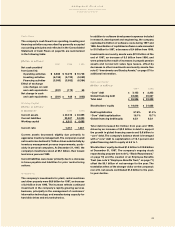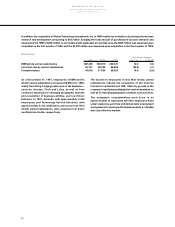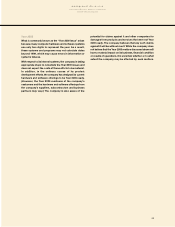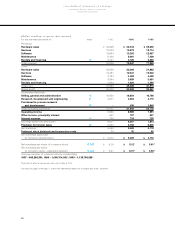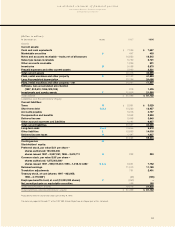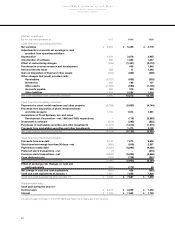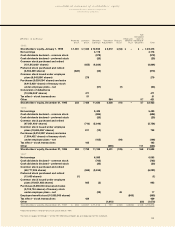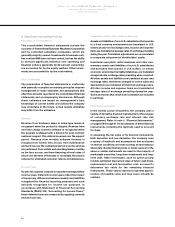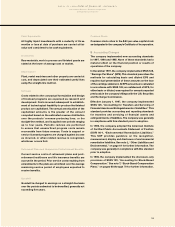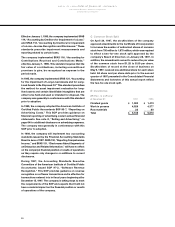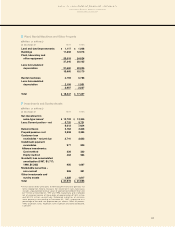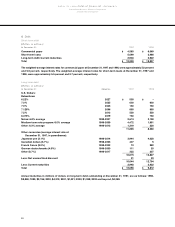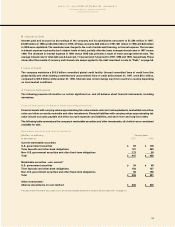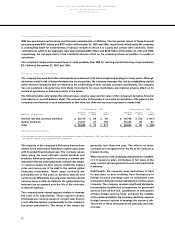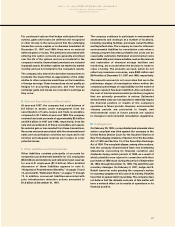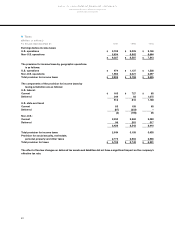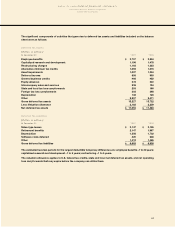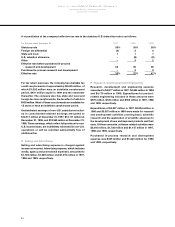IBM 1997 Annual Report Download - page 56
Download and view the complete annual report
Please find page 56 of the 1997 IBM annual report below. You can navigate through the pages in the report by either clicking on the pages listed below, or by using the keyword search tool below to find specific information within the annual report.
ASignificant Accounting Policies
Principles of Consolidation
The consolidated financial statements include the
accounts of International Business Machines Corporation
and its controlled subsidiary companies, which are
generally majority owned. Investments in business enti-
ties in which IBM does not have control, but has the ability
to exercise significant influence over operating and
financial policies (generally 20-50 percent ownership),
are accounted for by the equity method. Other invest-
ments are accounted for by the cost method.
Use of Estimates
The preparation of financial statements in conformity
with generally accepted accounting principles requires
management to make estimates and assumptions that
affect the amounts reported in the consolidated financial
statements and accompanying disclosures. Although
these estimates are based on management’s best
knowledge of current events and actions the company
may undertake in the future, actual results ultimately
may differ from the estimates.
Revenue
Revenue from hardware sales or sales-type leases is
recognized when the product is shipped. Revenue from
one-time-charge licensed software is recognized when
the program is shipped with a deferral for post-contract
customer support. This deferral is earned over the support
period. Revenue from monthly software licenses is
recognized as license fees accrue; from maintenance
and services over the contractual period or as the services
are performed; from rentals and operating leases, monthly
as the fees accrue; and from financing at level rates of
return over the term of the lease or receivable. Revenue is
reduced for estimated customer returns and allowances.
Income Taxes
Income tax expense is based on reported earnings before
income taxes. Deferred income taxes reflect the impact
of temporary differences between assets and liabilities
recognized for financial reporting purposes and such
amounts recognized for income tax purposes. In
accordance with Statement of Financial Accounting
Standards (SFAS) 109, “Accounting for Income Taxes,”
these deferred taxes are measured by applying currently
enacted tax laws.
Translation of Non-U.S. Currency Amounts
Assets and liabilities of non-U.S. subsidiaries that operate
in a local currency environment are translated to U.S.
dollars at year-end exchange rates. Income and expense
items are translated at average rates of exchange prevailing
during the year. Translation adjustments are accumulated
in a separate component of stockholders’ equity.
Inventories and plant, rental machines and other non-
monetary assets and liabilities of non-U.S. subsidiaries
and branches that operate in U.S. dollars, or whose
economic environment is highly inflationary, are translated
at approximate exchange rates prevailing when acquired.
All other assets and liabilities are translated at year-end
exchange rates. Inventories charged to cost of sales and
depreciation are translated at historical exchange rates.
All other income and expense items are translated at
average rates of exchange prevailing during the year.
Gains and losses that result from translation are included
in earnings.
Financial Instruments
In the normal course of business, the company uses a
variety of derivative financial instruments for the purpose
of currency exchange rate and interest rate risk
management. Refer to note J, “Financial Instruments,”
on pages 59 through 61 for descriptions of these financial
instruments, including the methods used to account
for them.
In assessing the fair value of its financial instruments,
both derivative and non-derivative, the company uses
a variety of methods and assumptions that are based
on market conditions and risks existing at each balance
sheet date. Quoted market prices or dealer quotes for the
same or similar instruments are used for the majority of
marketable securities, long-term investments and long-
term debt. Other techniques, such as option pricing
models, estimated discounted value of future cash flows,
replacement cost and termination cost, are used to
determine fair value for the remaining financial
instruments. These values represent a general approx-
imation of possible value and may never actually be
realized.
notes to consolidated financial statements
International Business Machines Corporation
and Subsidiary Companies
54



